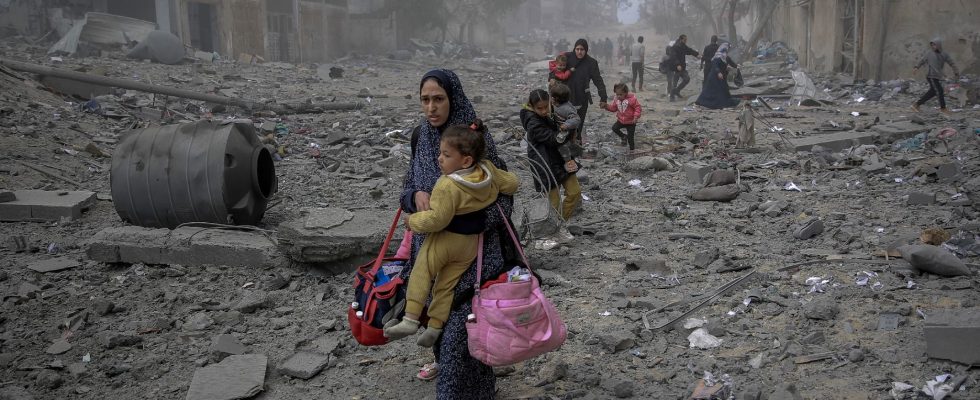A new alarm signal raised by the UN. While the various branches of the United Nations are calling day by day for an end to the fighting in the Gaza Strip and for a vastly increased entry of humanitarian aid, it is this time a report on food insufficiency and famine in the Palestinian enclave which warns of the infinitely difficult situation for the civilian populations.
This report, published this Monday March 18, was established by a technical body, the Integrated Food Safety Classification Framework (IPC). This is based on data from two UN agencies: the World Food Program (WFP) and the Food and Agriculture Organization (FAO). It analyzes and classifies the severity of food insecurity on a scale based on international scientific standards. With a clear observation: the risk of famine in the Gaza Strip is only getting worse day by day, particularly in the north of the enclave, L’Express returns for you to these latest figures on the humanitarian situation in Gaza .
What are the criteria for a famine situation?
Famine is defined by the IPC as “a state of extreme food deprivation.” “Critical levels of starvation, death, destitution and acute malnutrition are evident or at risk of becoming so,” adds the organization. The “starvation” classification represents the highest severity phase of the IPC acute food insecurity scale, which has five stages: phase 1 (“minimal”), phase 2 (“stress”) , phase 3 (“crisis”), phase 4 (“emergency”), and finally phase 5 (“disaster/famine”).
Phase 5 is reached when an area meets these three criteria: at least 20% of households are faced with an extreme lack of food; at least 30% of children suffer from acute malnutrition; and at least two people in 10,000 or at least four children under five in 10,000 die every day from starvation or an interaction of malnutrition and disease.
However, there is no threshold clearly defined by the IPC for a famine situation. Still according to the organization, once the data is published and available to all, “it is up to relevant stakeholders at the country level, such as government authorities and United Nations agencies, to declare a famine.” The last two famines declared by the UN date back to 2017 in South Sudan and 2011 in Somalia.
Are these criteria met in Gaza?
Currently, the situation is already extremely difficult. As of March 15, 30% of the Gaza population, or 670,000 people, were in phase 5, or “starvation”. To this, we can add 39% of inhabitants who are in an “emergency” situation (876,000 people), and 26% in a food “crisis” (578,000 people). Finally, in the two districts in the north of the Gaza Strip alone (Gaza North and Gaza City), 55% of the population would be in a situation of famine (165,000 people) and 25% in a food emergency (75,000 people). ).
But it is especially in the projection planned for the coming months that the situation should become critical, warns the IPC. Thus, “in the most likely scenario and in the hypothesis of an escalation of the conflict, including a ground offensive in Rafah”, nearly 1.1 million Gazans would fall into a situation of famine. This is “the highest number ever recorded by the IPC of people facing a catastrophic food situation”, the WFP underlined this Monday.
Here too, a particularly deteriorated situation in the north of Gaza, with nearly 70% of the population said to be in famine and 30% in emergency. Enough to make the IPC say that “famine is imminent in the northern districts and is expected to occur at any time between mid-March and May 2024”, while the famine situation in the three other districts in the south and in central Gaza is expected to occur “between mid-March and mid-June, in the worst-case scenario with a reasonable chance of occurring.”
What is the UN asking for?
If these data remain projections – deemed “plausible” by the UN body, the latter insists on not waiting for a future assessment in the coming months to react. “It is essential to note that the predicted famine can be avoided or mitigated. All evidence points to a major acceleration in deaths and malnutrition. It is indefensible to wait for a retrospective classification of famine before taking action,” writes the IPC in the conclusion of his report.
However, according to the WFP, there is still “a narrow window” to prevent famine. The measures necessary to prevent this imminent risk are to be found in an “immediate cessation of hostilities”, “full access to food, water, medicine, as well as the protection of civilians”, as well as the “recovery and health, water and sanitation services, as well as energy to the population of the northern districts.”
A rapid “immediate humanitarian ceasefire” would allow “enough food, medicine and drinking water to enter” the areas to avoid famine, FAO Deputy Director General Berth Bechdol told AFP. , but a cessation of hostilities “does not seem likely in the days or weeks to come”.
At the same time, the UN has been calling since the start of the conflict for a significant increase in the entry of humanitarian aid into the Palestinian enclave. Still according to the WFP, to ensure basic food needs, it would be necessary to bring into Gaza “at least 300 trucks per day”, particularly in the North, where it has only been able to transport nine aid convoys since the start of the year. The last 18 trucks of food aid were delivered to Gaza City on Sunday evening. Insufficient, for the moment, to prevent a possible large-scale food crisis.
